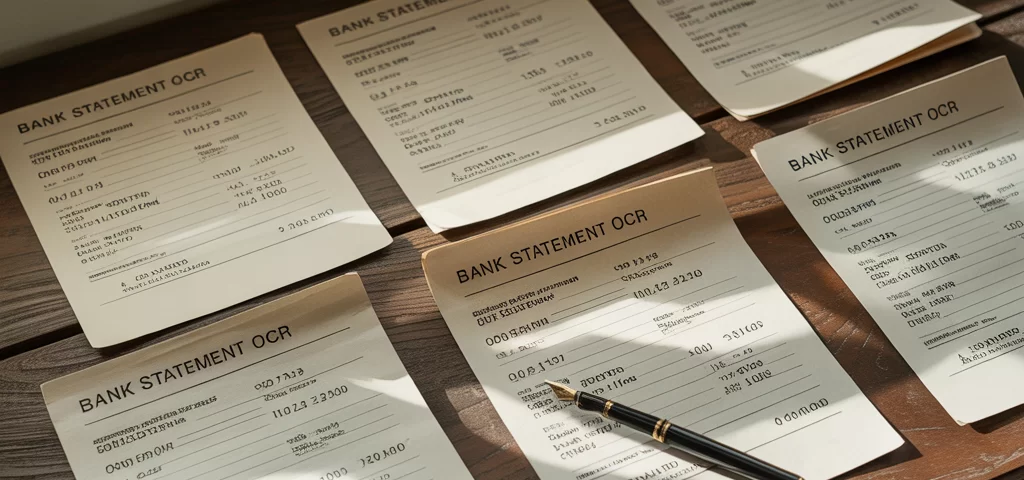Best OCR Solution for Bank Statements: A Comprehensive Guide
Купить чиллер для охлаждения воды
May 16, 2025Щенки породы кане корсо с доставкой по Москве
May 16, 2025In today’s digital-first financial landscape, converting paper bank statements into usable digital data has become essential for both individuals and businesses. This is where bank statement OCR (Optical Character Recognition) technology comes into play, transforming the way we process, analyze, and store financial information. But with numerous options available, finding the right OCR solution for your specific needs can be challenging.
What Is Bank Statement OCR?
Bank statement OCR refers to specialized optical character recognition technology designed to extract and digitize information from bank statements. Unlike general OCR software, bank statement OCR is specifically calibrated to recognize and process financial documents with their unique formats, terminologies, and data structures.
These specialized systems can automatically identify account numbers, transaction dates, merchant names, deposit and withdrawal amounts, and running balances—converting them into structured, searchable, and analyzable data.
Why You Need Specialized OCR for Bank Statements
Bank statements pose unique challenges for OCR technology due to their:
- Complex layouts with tables, columns, and varying formats
- Specialized financial terminology and notation
- Need for extremely high accuracy when dealing with financial figures
- Security requirements for handling sensitive financial information
- Variety of formats across different banking institutions
Using generic OCR for bank statements often results in errors, misinterpreted data, and extensive manual correction. Specialized bank statement OCR systems are trained specifically on financial documents, delivering significantly higher accuracy and reducing post-processing work.
Top Bank Statement OCR Solutions in 2025
1. Caelum AI
Strengths:
- Specifically designed for financial document processing
- Advanced AI that continuously improves with use
- Handles multiple bank statement formats efficiently
- Exceptional accuracy rates exceeding 98% for most bank statements
- Robust data validation features
Limitations:
- Higher pricing tier for enterprise features
- Some users report steeper learning curve for customization
2. ABBYY FlexiCapture
Strengths:
- Enterprise-grade solution with decades of OCR experience
- Powerful recognition engine with high accuracy
- Comprehensive workflow automation options
- Excellent handling of complex layouts and tables
- Strong security features
Limitations:
- More expensive than many alternatives
- Can be complex to implement without technical expertise
- Might be overkill for smaller businesses
3. Rossum
Strengths:
- AI-powered document understanding platform
- Intuitive interface requiring minimal setup
- Learns from corrections to improve accuracy over time
- Good integration capabilities with accounting systems
- Excellent customer support
Limitations:
- Better suited for businesses than individuals
- Some users mention occasional issues with very complex statement formats
4. Nanonets
Strengths:
- No-code platform accessible to non-technical users
- Excellent accuracy with minimal training
- Reasonably priced for small to medium businesses
- Good API for developers
- Strong mobile capture capabilities
Limitations:
- Limited template options for some regional banks
- Some users report occasional delays in processing high volumes
5. Amazon Textract
Strengths:
- Powerful AI-backed OCR from AWS
- Pay-per-use pricing model
- Strong security and compliance features
- Excellent for developers through comprehensive APIs
- Can handle high volumes efficiently
Limitations:
- Requires technical expertise to implement effectively
- Less specialized for bank statements specifically
- May need additional customization for optimal results
Key Features to Look for in Bank Statement OCR
When evaluating bank statement OCR solutions, consider these essential features:
Accuracy and Recognition Capabilities
- High text recognition accuracy: Look for solutions claiming at least 95% accuracy rates specifically for financial documents
- Table structure recognition: The ability to maintain the integrity of tabular data
- Multi-language support: Essential if you deal with international banking documents
- Handwriting recognition: Useful for dealing with annotated statements
Integration and Workflow
- Accounting software integration: Direct connections to QuickBooks, Xero, or other financial systems
- Cloud storage compatibility: Easy export to services like Dropbox, Google Drive, or OneDrive
- API availability: For custom integration with your existing systems
- Batch processing capabilities: The ability to process multiple statements efficiently
Security and Compliance
- Data encryption: Both in transit and at rest
- Compliance certifications: Look for SOC 2, GDPR, and other relevant security standards
- Data retention policies: Clear policies about how your financial data is stored and for how long
- Access controls: User permission settings and audit trails
User Experience
- Intuitive interface: Minimal learning curve for daily users
- Mobile capabilities: Smartphone scanning options for on-the-go capture
- Error correction tools: Easy ways to verify and fix recognition errors
- Customer support: Available help when issues arise
Implementation Best Practices for Bank Statement OCR
To get the most from your bank statement OCR implementation:
- Start with a pilot program focusing on statements from your most commonly used banks
- Establish clear workflows for both the OCR process and exception handling
- Train users properly on the system and verification procedures
- Regularly audit accuracy by comparing OCR results with original statements
- Keep your templates updated when banks change their statement formats
- Take advantage of automation features to reduce manual processing
- Implement proper security protocols for handling sensitive financial data
Cost Considerations for Bank Statement OCR
Bank statement OCR solutions typically follow several pricing models:
- Per-page pricing: Charges based on the volume of pages processed
- Subscription models: Monthly or annual fees with set processing limits
- Pay-as-you-go plans: Flexible pricing based on actual usage
- Enterprise agreements: Custom pricing for large-scale implementations
For small businesses or individuals, expect to pay between $0.05 to $0.20 per page for pay-per-use services, or $50-200 monthly for subscription services with reasonable volume allowances.
Enterprise solutions with advanced features and high-volume capabilities typically range from $500 to several thousand dollars monthly, depending on requirements and customization needs.
The Future of Bank Statement OCR
The bank statement OCR landscape continues to evolve with several emerging trends:
- AI-powered contextual understanding: Going beyond simple text recognition to interpret the meaning and relationships within financial data
- Automated reconciliation: Direct matching of OCR data with accounting system entries
- Real-time processing: Immediate extraction and verification as statements are received
- Enhanced fraud detection: AI capabilities to identify unusual patterns or potential document tampering
- Mobile-first approaches: Improved capture and processing directly from smartphone cameras
These advancements are making bank statement OCR increasingly accessible and valuable for organizations of all sizes, from individuals managing personal finances to enterprise-level financial operations.
Conclusion
Selecting the right bank statement OCR solution requires careful consideration of your specific needs, volume of statements, technical capabilities, and budget. The best solutions offer high accuracy, seamless integration with your existing systems, strong security features, and user-friendly interfaces.
For most businesses, investing in specialized bank statement OCR technology pays dividends through significant time savings, reduced manual data entry errors, and improved financial data accessibility. The ability to quickly digitize, search, and analyze bank statement data transforms financial record-keeping from a tedious chore into a strategic advantage.
As you evaluate options, consider starting with free trials offered by most vendors to test their capabilities with your specific bank statements before making a final decision.
How accurate is bank statement OCR technology?
Modern bank statement OCR solutions typically achieve accuracy rates between 95-99% for well-formatted documents from major banks. However, accuracy can vary depending on statement quality, formatting complexity, and whether the system has been trained on your specific bank’s statement format.
Can bank statement OCR work with statements from any bank?
Yes, most advanced bank statement OCR solutions can handle statements from a wide range of banks. However, some systems perform better with major banks whose formats they’ve been extensively trained on. For less common or regional banks, you might need to create custom templates or provide training samples.
Is bank statement OCR secure enough for sensitive financial information?
Reputable bank statement OCR providers implement robust security measures including encryption, secure data centers, and compliance with financial industry standards. Always verify that any solution you choose meets your region’s data protection requirements and offers appropriate security certifications.
Can I use regular OCR software for bank statements?
While general-purpose OCR software can extract text from bank statements, it typically lacks the specialized capabilities needed for accurate financial data extraction. General OCR often struggles with table structures, financial notation, and the specific formatting used in bank statements, resulting in more errors and manual correction work.
How long does it take to implement a bank statement OCR solution?
Implementation timelines vary widely based on the solution chosen and your specific requirements. Cloud-based SaaS solutions can be operational within days, while enterprise-level, highly customized implementations might take several weeks or months, especially if integration with other systems is required.
Does bank statement OCR eliminate the need for manual review?
While good bank statement OCR significantly reduces manual data entry, prudent financial practice still requires some level of human verification. Most organizations implement a verification step where OCR results are quickly reviewed before being finalized, focusing human attention on flagged exceptions rather than routine data entry.
What’s the difference between bank statement OCR and general document OCR?
Bank statement OCR is specifically optimized for financial documents with specialized features for recognizing numerical data, table structures, transaction formatting, and financial terminology. General document OCR lacks these specialized capabilities and typically delivers lower accuracy for financial documents.




